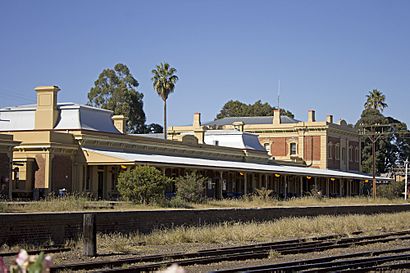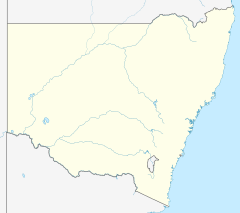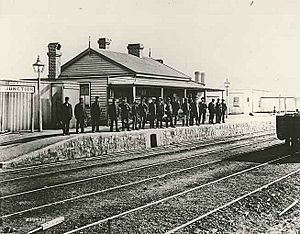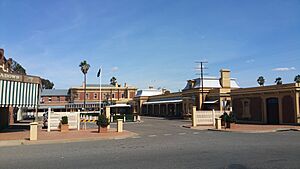Junee railway station facts for kids
Quick facts for kids
Junee
|
||||||||||||||||||||||||||||
|---|---|---|---|---|---|---|---|---|---|---|---|---|---|---|---|---|---|---|---|---|---|---|---|---|---|---|---|---|

Southbound view of platform and building, April 2012
|
||||||||||||||||||||||||||||
| Location | Railway Square, Junee | |||||||||||||||||||||||||||
| Coordinates | 34°52′13″S 147°35′02″E / 34.870210°S 147.583950°E | |||||||||||||||||||||||||||
| Owned by | Transport Asset Holding Entity | |||||||||||||||||||||||||||
| Operated by | NSW TrainLink | |||||||||||||||||||||||||||
| Line(s) | Main Southern Hay |
|||||||||||||||||||||||||||
| Distance | 485.67 kilometres from Central | |||||||||||||||||||||||||||
| Platforms | 1 | |||||||||||||||||||||||||||
| Tracks | 12 | |||||||||||||||||||||||||||
| Construction | ||||||||||||||||||||||||||||
| Structure type | Ground | |||||||||||||||||||||||||||
| Other information | ||||||||||||||||||||||||||||
| Status |
Staffed: 10.30am-2.45pm
|
|||||||||||||||||||||||||||
| Station code | JUE | |||||||||||||||||||||||||||
| History | ||||||||||||||||||||||||||||
| Opened | 6 July 1878 | |||||||||||||||||||||||||||
| Previous names | Junee Junction (1881-1940) | |||||||||||||||||||||||||||
| Services | ||||||||||||||||||||||||||||
|
||||||||||||||||||||||||||||
|
||||||||||||||||||||||||||||
| Location | ||||||||||||||||||||||||||||
Junee railway station is a historic train station located in the town of Junee, New South Wales, Australia. It's an important stop on the Main Southern railway line. This station is special because it's listed on the New South Wales State Heritage Register, meaning it's a significant historical site. It was added to the register on 2 April 1999.
Contents
Train Services at Junee
Junee station is a busy place for train travel. It serves two main types of trains operated by NSW TrainLink.
Daily XPT Services
There are two daily XPT train services. These trains travel in both directions. They connect Sydney and Melbourne.
Twice-Weekly Xplorer Services
A Xplorer train also stops here twice a week. This service runs between Griffith and Sydney. Part of this train separates from Canberra services at Goulburn.
History of Junee Station
Junee station first opened on 6 July 1878. This happened when the Main Southern railway line was extended. It was the end of the line for a short time. The line was then extended to Bomen on 3 September 1878.
Name Changes and Growth
The station was first called Junee. On 28 February 1881, its name changed to Junee Junction. This was when the Hay railway line opened, connecting to Narrandera. In April 1940, it went back to its original name, Junee.
A wooden station building was built first. As more branch lines opened, Junee became a major railway hub. Railway workshops were even moved here from Wagga. This made Junee grow very quickly in the 1880s.
New Station Building
The original wooden station building unfortunately burned down in January 1882. Plans for a new, stronger building were approved in February 1883. The current station, which cost £3,434, opened on 5 March 1885. It was designed under the direction of John Whitton, a famous railway engineer.
Junee Locomotive Depot
In January 1947, a large, covered roundhouse was finished. This Junee Locomotive Depot was the last steam locomotive depot built by the New South Wales Government Railways. It was a place where steam trains were repaired and maintained.
The State Rail Authority closed the depot in July 1993. Today, it's leased to a company that repairs trains, Junee Railway Workshop. It also houses the Junee Roundhouse Railway Museum, where you can see old trains.
Recent Changes
On 23 December 1999, a footbridge and signal gantry at the north end of the station were damaged. They were hit by a container and had to be removed.
Station Description
The Junee railway station area includes the main station building, the train yard, and the locomotive depot/roundhouse.
The Station Building (1883)
The station building is a great example of Victorian Italianate Renaissance style. It looks grand and fits well with other important buildings in Junee.
It was built in 1883 under John Whitton's guidance. The building has a central section with a hidden roof and two square towers on each side. It's made of brick and stucco. There's a fancy iron verandah at the entrance and along the platform. The building also features decorative details around the windows and on its corners.
The station complex once had a beautiful garden room. It featured a fountain, a pond, and flower beds.
The Locomotive Depot / Roundhouse
The roundhouse at Junee is a large, circular building. It has 42 tracks arranged like spokes of a wheel around a central turntable. This design allowed trains to be moved easily for repairs and maintenance.
The building is made of brick with a peaked roof. It originally had smoke chutes to let out smoke from steam locomotives. Some of these were changed when diesel trains arrived. Inside, there are inspection pits for working on the trains.
Other important parts of the depot include a 100-foot wide electrically operated turntable, a machine shop, and other buildings for staff and storage.
Condition of the Buildings
The station building and roundhouse have been used for many years. They have seen some wear and tear.
However, they are in good condition overall. Some minor changes were made over time, especially as steam trains were replaced by diesel trains. But the main structure and its original features are still there. This means the buildings still look and feel like they did when they were first built.
Why Junee Station is Important
Junee railway station is a very important historical site in New South Wales.
A Major Train Hub
It was one of the main places for servicing and maintaining steam locomotives. These trains were used in the southern part of the state. The depot helped keep trains running on the main lines and many branch lines.
The 42-track roundhouse was completed in the late 1940s. It was the largest complete roundhouse building in the state. For over 25 years, it serviced and repaired the biggest steam trains in New South Wales. The depot was used by the government for about 46 years.
Preserving History
Many old railway centers have been torn down or changed a lot. Junee is special because many of its important parts are still here.
In the 1940s and 1950s, when steam trains were at their peak, Junee was a huge railway center. It had a large station, a big train yard, signal boxes, and a modern locomotive depot. This depot had a roundhouse, a coal bunker for fueling trains, and a machine shop. All these things were needed to quickly service and repair steam trains.
Even though some parts have been removed (like the coal bunker), the roundhouse and other items are still in good condition. The roundhouse at Junee is a great example of a once very busy and important train servicing center. It shows how important railways were to the state's development.
Historical Significance
The roundhouse and turntable at Junee are historically important for the whole state. They show a key part of a major locomotive depot. This depot was responsible for keeping trains running reliably on the main southern line and its many branch lines.
Community Connection
Railway stations and depots were huge employers. The "railways" were the biggest employer in NSW for many years. They operated 24/7, and many people worked to keep them going.
The Junee locomotive depot provided many jobs in the southern region. The wages from these jobs helped the local economy. Local businesses also thrived by supplying goods and services to the railway. Big, busy railway facilities often meant success and wealth for a town.
Learning from the Past
The Junee locomotive depot, with its roundhouse and other buildings, shows us a past era. It illustrates a time when trains were the main way to transport people and goods. The roundhouse and its equipment were essential for these busy train activities.
The site is important for research because it's a remnant of a time when railways were crucial for transport.
A Rare Example
Steam locomotives were the main type of train in New South Wales for about 110 years (1855–1965). Many servicing facilities were built, including about 25 roundhouses.
By 2002, only nine roundhouses (or parts of them) remained in the state. The Junee roundhouse is considered a rare and important example of New South Wales's history. It represents a type of industrial building that has almost disappeared.
Images for kids





